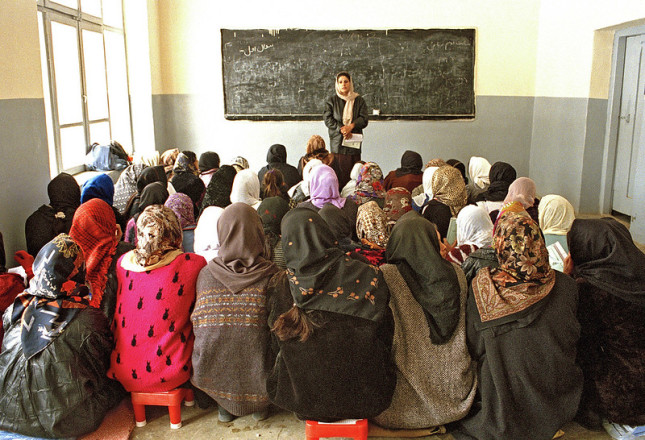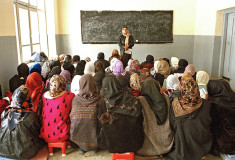-
Connecting the Dots: The Interplay between Education and Sexual and Reproductive Health
August 30, 2023 By Maniza Habib
The importance of quality education for girls cannot be understated. And when global thought leaders, policymakers, gender advocates, and researchers convened in Rwanda in July at the Women Deliver 2023 Conference, it was a chance to discuss a topic increasingly at the forefront of global conversation: How can quality education advance gender equality and empowerment worldwide?

The importance of quality education for girls cannot be understated. And when global thought leaders, policymakers, gender advocates, and researchers convened in Rwanda in July at the Women Deliver 2023 Conference, it was a chance to discuss a topic increasingly at the forefront of global conversation: How can quality education advance gender equality and empowerment worldwide?
The world’s attention could not be timelier. Earlier in July, Malala Yousafzi and United Nations (UN) Deputy Secretary-General Amina J. Mohamed joined together in Nigeria to celebrate a decade of progress since Yousafzi took a stand for worldwide access to education at the UN headquarters when she was just 16 years old. While there is much to celebrate, Yousafzi also warned about the challenges that remain and stressed that time to promote innovative and upstream approaches to girls’ educational achievement is now.
Education as a Catalyst for Change
Education is a fundamental human right that both empowers individuals and fosters societal progress. Indeed, Goal 4 of the 2030 Sustainable Development Goals aims to “ensure inclusive and equitable quality education and promote lifelong learning opportunities for all.”
Yet, as illustrated by the challenging landscapes in Afghanistan, Sudan, and Myanmar, girls continue to face numerous barriers in accessing quality education. There are many reasons for this, including unsafe conditions and improper infrastructure, poverty, child marriage, and other sociocultural factors. Around the world, an estimated 129 million girls miss out on school. Barring girls from accessing education is not only a gross violation of human rights – it is also a disservice for all global communities.
The benefits of access are clear, however. Girls’ education has been cited as the world’s best investment, with the widest-ranging returns. For instance, investing in girls’ education in the Global South has had multifaceted benefits, including reduced child and maternal deaths, improved child health, and overall greater gender equality.
When girls receive an education, they are more likely to marry later, have fewer children, and participate in the workforce. Delaying marriage and childbirth also allows girls to prioritize their education, and thereby improves their economic prospects and increasing contributions to their families’ financial stability. Furthermore, research shows that when a mother is educated, she is more likely to invest in her children’s education—creating a positive ripple effect for future generations.
A Mutually Reinforcing Relationship
Investment in girls’ education reaps almost unanimous praise—and overall agreement on its critical role in achieving gender equality. Yet there must be more than mere investment in schooling. One way to improve educational attainment among girls and fill the gender gap is to advance sexual and reproductive health and rights (SRHR). Increasing funding for programs that prevent child marriage and adolescent pregnancy plays a key role in improving educational attainment among girls.
The reason? A mutually reinforcing relationship between girls’ education and SRHR. One study estimates that each year of secondary school education, on average, reduces the risk of child marriage or having a first child before the age of 18 by upwards of 6 percentage points. Moreover, studies have shown that early and unintended pregnancies have a significant connection with adolescents dropping out of school. The current status of SRHR in the Global South indicates a dire need for investments in SRHR services, especially for adolescent girls, in order to fulfill global commitments to ensuring equitable education.
Schools have the potential to be an avenue for promoting the health and well-being of children and adolescents through comprehensive sexuality education (CSE). A quality education equips girls with knowledge about their bodies, reproductive health, and their rights, and CSE has been shown to lead to positive SRHR outcomes.Moreover, CSE can provide an opportunity to incorporate teachings on menstrual health management (MHM). A lack of MHM education and access to menstrual materials can lead to greater health risks among adolescent girls, including a discontinuation of their formal education, early marriage, and a young childbearing age. Despite young people making it clear that CSE is important to them, it remains unavailable and underfunded across the world.
Finding the Way Forward
Investments in global SRHR can have positive impacts in multiple areas, including girls’ education. By increasing SRHR funding, we can create an enabling environment for girls and their educational pursuits. Research consistently demonstrates that increasing girls’ education serves as a powerful deterrent against child marriage and early pregnancies and leads to improved access to comprehensive SRHR services. And, since a lack of access to SRHR is a significant barrier to post-primary education, addressing this barrier also remains a priority.
Promoting gender equality and empowerment stands as an undisputed universal and sustainable development goal. Achieving global gender equality necessitates the adoption of focused efforts on women’s and girls’ health, as well as a recognition of the profound influence that access to comprehensive SRHR has on girls’ education. By recognizing the fundamental interplay between SRHR and girls’ education, investing in comprehensive SRHR initiatives will become a pivotal strategy to unlock the full potential of girls—and foster inclusive and equitable societies.
Maniza Habib is the Research Associate at the Population Institute.
Sources: BBC; Brookings; CNN; Comparative Education; Demography; Global Affairs; Guttmacher Institute; PPPF; PLOS One; Population Institute; Relief Web; Reproductive Health; UN; UNICEF; Women Deliver 2023 Conference; World Bank.
Photo Credit: UNICEF supplies the Zarghuna Girls School with educational supplies, teachers’ training, and assists in repairing the infrastructure. UN Photo/Eskinder Debebe.
 A Publication of the Stimson Center.
A Publication of the Stimson Center.




